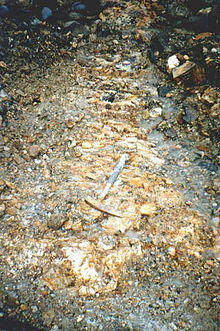
In geology, a lode is a deposit of metalliferous ore that fills or is embedded in a fissure (or crack) in a rock formation or a vein of ore that is deposited or embedded between layers of rock.[1] The current meaning (ore vein) dates from the 17th century, being an expansion of an earlier sense of a "channel, watercourse" in late Middle English, which in turn is from the 11th-century meaning of lode as a ‘course, way’.[2]
The generally accepted hydrothermal model of lode deposition posits that metals dissolved in hydrothermal solutions (hot spring fluids) deposit the gold or other metallic minerals inside the fissures in the pre-existing rocks.[3] Lode deposits are distinguished primarily from placer deposits, where the ore has been eroded out from its original depositional environment and redeposited by sedimentation.[4] A third process for ore deposition is as an evaporite.
A stringer lode is one in which the rock is so permeated by small veinlets that rather than mining the veins, the entire mass of ore and the enveined country rock is mined. It is so named because of the irregular branching of the veins into many anastomosing stringers, so that the ore is not separable from the country rock.[5]
One of largest silver lodes was the Comstock Lode in Nevada,[6] although it is overshadowed by the more recently discovered Cannington Lode in Queensland, Australia.[7][8] The largest gold lode in the United States was the Homestake Lode.[9] The Broken Hill Lode in South Australia is the largest lead-zinc lode ever discovered.[10]
See also
- Lodestone, known just as lode in the 16th and 17th centuries.[11][2]
- Mother lode, the principal vein
- Ore genesis
- Thickness
Notes
- ^ Thompson, Joseph Wesley (1913). "Lode Locations". Abstracts of Current Decisions on Mines and Mining, March to December, 1914. Bulletin 79, Law Serial 2. Bureau of Mines, U.S. Department of the Interior. p. 13. OCLC 29112728.
- ^ a b "lode". Oxford English Dictionary (Online ed.). Oxford University Press. (Subscription or participating institution membership required.)
- ^ Fournier, R.O. (1999). "Hydrothermal processes related to movement of fluid from plastic into brittle rock in the magmatic environment". Economic Geology and the Society of Economic Geologists. 18: 486–497.
- ^ McGregor, Tisha; et al. (2000). "Mining the Motherlode: Lode vs. Placer Mining". Wells, California: Wells Historical Society. Archived from the original on 29 May 2002.
- ^ Wood, George McLane, ed. (1916). Suggestions to authors of papers submitted for publication by the United States Geological Survey with directions to typewriter operators. Washington, DC: United States Geological Survey. p. 35. OCLC 7678360.
- ^ Smith, Grant Horace (1943). The History Of The Comstock Lode. Reno, Nevada: Nevada State Bureau of Mines and the Mackay School of Mines. OCLC 3145590.
- ^ Staff (2007). "Cannington Silver and Lead Mine, Queensland, Australia". Mining-technology.com of Net Resources International. Archived from the original on 31 December 2007.
- ^ Walters, Stephen; Bailey, Andrew (1998). "Geology and mineralization of the Cannington Ag-Pb-Zn deposit; an example of Broken Hill-type mineralization in the eastern succession, Mount Isa Inlier, Australia". Economic Geology. 93 (8): 1307–1329. doi:10.2113/gsecongeo.93.8.1307.
- ^ Yarrow, Andrew L. (9 August 1987). "Beneath South Dakota's Black Hills". The New York Times. Retrieved 2008-01-11.
Homestake, which is the largest, deepest and most productive gold mine in North America, has yielded more than $1 billion in gold over the years.
- ^ Staff (February 2007). "Curnamona Geology". Department for Manufacturing, Innovation, Trade, Resources and Energy, Government of South Australia.
- ^ The New Oxford American Dictionary (NOAD), 3rd edition.